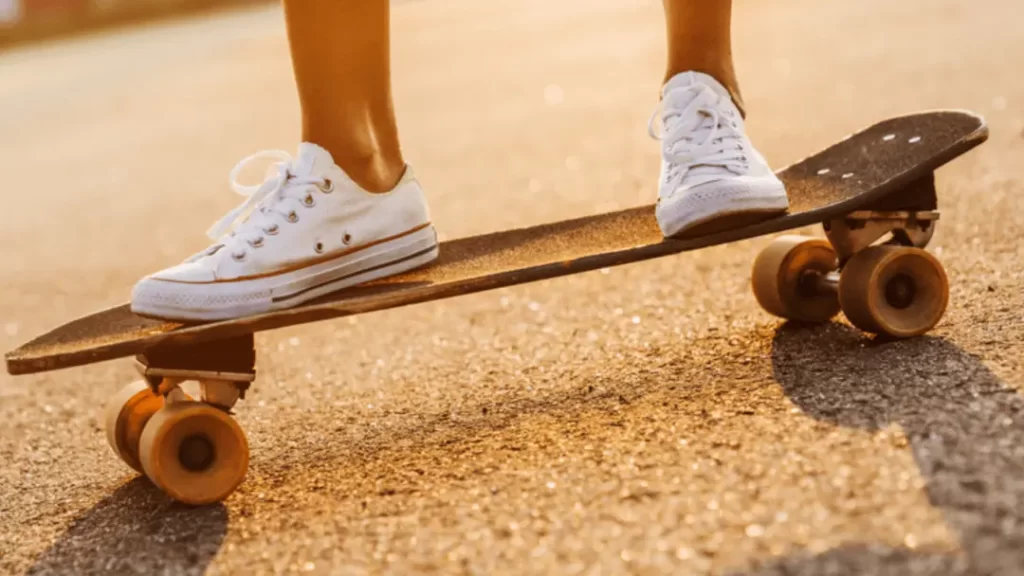Stability, control, and speed are three must-have aspects of longboarding, and they all depend on how you place your foot on the board. So if you don’t know how to place your feet on a longboard, you’ll end up longboarding with worse experiences, even several injuries. But placing your feet on a longboard varies depending on your riding style.
That’s why we come up to teach you several standing positions on the longboard with certain styles, along with applying process. Before that, let’s learn a basic technique for standing on a longboard so you can start from the initial stage.
How to Place your Feet on a Longboard
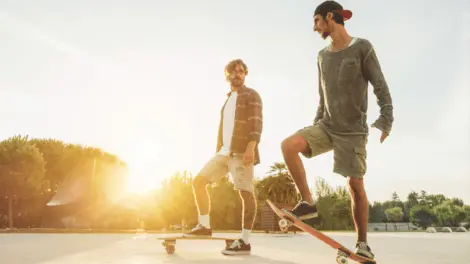
Generally, you can stand on a longboard in two different ways: a goofy stance and a regular one. Goofy stance means using the left foot as the back foot and the right foot as the front foot on the longboard. Conversely, in the regular stance, the rider places their front foot in the back and their left foot in the foot on the longboard.
Between them, a goofy stance is the most popular and easiest way to ride the longboard, even for beginners. So let’s learn the process by following this goofy stance technique.
Place the Longboard
Place the longboard on the flat ground close to you. As a beginner, start with your feet shoulder-width apart.
Place the Front Foot
Place the front foot on the middle of the longboard. Be careful as it will determine the comfort of starting the riding.
Place the Rear Foot
Many people feel it is easy and comfortable to ride while keeping their back foot hanging off the tail at the end of the longboard. It also helps keep the board stable and offers better control while turning.
To place the back foot, put the foot’s heel on the board’s tail. Then turn the foot so that the toes remain pointing in your moving direction.
Bend the Knees
Bending the knees is a crucial part of riding a longboard. It keeps the body well-balanced and allows it to turn easily. Remember, while bending the knees, you must keep the feet planted on the board securely. Otherwise, you won’t get the stability and desired control.
Slowly start to bend your knees until your body reaches halfway to the ground. Hold this position for a while before going back to the original shape. Practice this frequently to feel comfortable and try to keep balance without falling off.
Lean Forward or Backward
Leaning is a way to turn on a board. It needs to lean its body weight in the direction you want to turn. To get a sharper turn, you have to lean frequently. Keep the knees bent and plant the feet securely on the longboard to lean without falling off.
Start Riding
Push off the longboard with the front foot to start riding. Along with gaining speed, you can start to lean, keeping the knees bent and plating the feet firmly on the longboard. Keep practicing to improve your skills and make the riding safer.
Right foot placement for different riding styles
Stance refers to the way a longboarder places his feet and the rest of his body on the longboard while riding. Depending on the style of riding, a rider can take various types of stances. So picking the right stance depends on whether the rider is riding casually, braking or foot pushing, carving, turning to slide, or speeding down a hill.
Despite this, the placement of the foot on the longboard is also determined by the shoulders and hips direction, the bending in the knees, and the leaning of the torso.
Cruising longboard stance
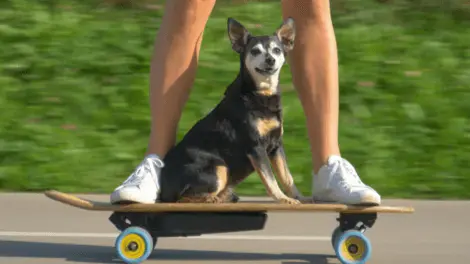
If you want to ride at low to moderate speed with a relaxed body, then you should become a master of this cruising longboard stance. To prepare for this stance, place your foot a bit wider than the width of the shoulder and maintain the same distance between the front and back truck. You can position your feet closer to the truck mounts or in between for a longer board if your wheelbase is short.
Across the width, place the front feet in the center of the board’s deck at around a 45-degree angle and keep the back foot perpendicular to the deck.
Bend the knees slightly to maintain balance during cruising. You can also turn the body subtly to face forward if desired. But don’t let the body tilt forward or backward during this position.
If you need to encounter an obstacle while keeping this stance, lean to the front and lower your knees.
Pushing longboard stance
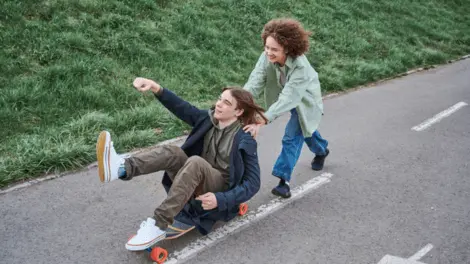
If you want to push to achieve some speed on a longboard, you must change the stance. Most of the time, the rider uses their front foot to steer while using their back foot to push to keep balance. For this pushing stance, place the front foot in front of the front truck bolts. The front leg should also remain parallel to the deck, facing through the nose.
However, some riders push themselves to apply the reversed stance as well. Then keep balance by placing the back foot close to the rear truck and hitting the ground to push with the front foot.
This stance makes it difficult to steer, and most people feel comfortable pushing using the back foot.
Carving longboard stance
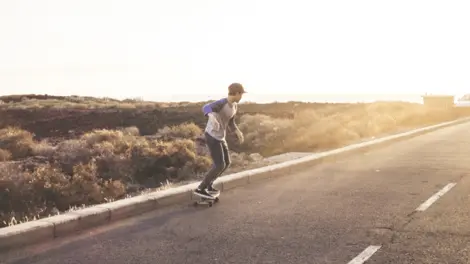
The rider applies a carving stance to rotate around the corner, either gaining or shedding speed. This riding style is quite technical, so the rider needs to be in the right stance. To perform carving, the rider needs to turn continuously by shifting their weight between their toes and heels.
For this carving stance, the longboarders need to place their front and back feet perpendicular across the longboard. It’s the opposite stance of cruising.
Knee bending and curling also impact hugely on this carving longboard stance. It’s also vital to move the center of gravity lower and press into the groove. The rider must then continuously turn the upper body in the opposite direction. After starting the sequential spins, the rider leans forward to keep balance.
Sliding longboard stance
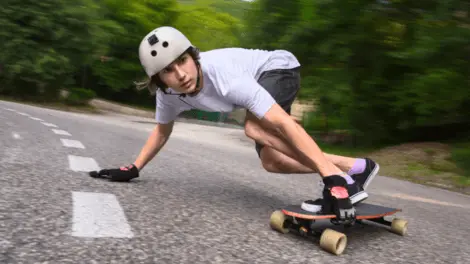
A rider can slide in plenty of ways, and each involves certain types of stances. Even some simple slides, like carve stance, push stance, and actual sliding stance, require several stances.
For a sliding stance, the feet need to be placed symmetrically on the deck. The feet should also be perpendicular and slightly more than shoulder-width apart. The heels hang a bit off the rail of the longboard, and both the heels push into the rail and away.
Speed stance
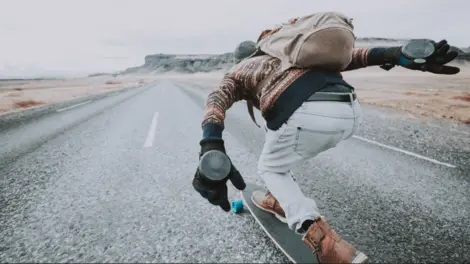
To ride speedily, the rider leans into a special stance, and it’s called a tuck. It means the rider gets the body into a position that reduces wind resistance and improves stability at high speed.
In this tuck stance, the rider places his front foot at a 15 to 30-degree angle with the deck of the board and near the front truck mount.
The rider keeps the back foot parallel to the front foot by resting it on its toes. The back foot remains behind the front foot, along with the long-distance. They place the toes near the edge of the longboard for easier front-side turning.
The rider cults their knee 90 degrees depending on the front leg to support the body weight. It means the front knee remains bent and the back knee gets tucked under it.
Then they tilt the body forward and lean the chest in the opposite direction of the front thigh. Doing so reduces the wind resistance. Finally, the rider holds their arms behind to keep balance.
Freestyle longboard stance
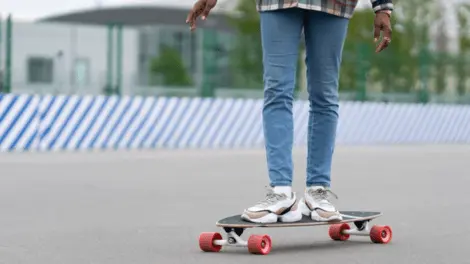
It’s the position of the foot when the rider does tricks and maneuvers on board. In this freestyle stance, the rider turns the front foot perpendicular to the board and turns the back foot around 45 degrees. Doing so lets the balls of the feet hug the board’s pocket from both sides.
This stance offers better stability compared to turning one-foot perpendicular to longboards. It also helps maintain the balance easily and offers better control over the longboard while doing ollies or shove-its.
It is also important to keep the front leg straight and the back leg at a 90-degree angle to the ground to practice a freestyle longboard stance. The rider should also be aware of which foot part should rest on the longboard and what should apply to maintain balance.
FAQs
1. What foot should a rider use when pushing on a longboard?
You should keep the front foot on the front side of the longboard and use the back foot to push. It’s a better way to ride the longboard and offers more control as well.
2. How to stop on a longboard?
You can stop on a longboard either by carving or foot baking. Most riders use foot baking techniques to prevent longboarding and the need to drag the back foot on the ground. It slows down the riding speed but increases the risk of knee locking.
In the carving, the rider needs to turn the longboard sharply from side to side. It scrapes the wheels against the ground and slows the rider down.
3. Is longboarding good exercise?
Longboarding is considered a solid aerobic activity as it allows you to burn 4 to 7 calories per minute. It is also a good strength and cardio exercise that help increase the flexibility of the entire body.
Final words
You can place your feet on a longboard in various ways. They won’t be effective or helpful if not meet the certain riding style which they are compatible with. So learning how to place your feet on longboard means understanding which stance to apply with a certain riding style.
Along with describing a basic longboard standing method, we have discussed plenty of longboard stances with their suitable styles and application process. Practicing these stances will improve your riding experience and optimum balance and control over the longboard.
Recommended Blog to Read:
Best Longboard Brands in 2022 For Beginner To Pro!
Volador Longboard Review | A Simple (But Complete) Guide
Magneto Bamboo Longboard Review : Best For Dancing!

Hi, my name is Gabriel. I am completed my MBA from private university and my subject was IT (Information Technology) and also I complete my graduation form South East University and Department from CSE (Computer Science & Engineering). I am author and blogger of this website who loves to write about different topics that are related to the board sport. From beginner tips to intermediate advice, I want to offer you quality content that will help improve your skill set and make you a better rider. Thanks for checking out my site!
